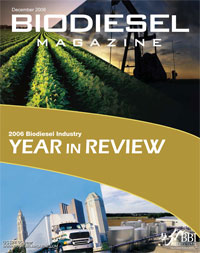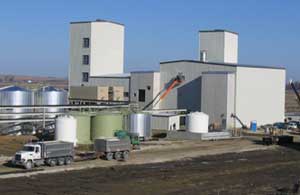December 2006
 View Full Print Edition
View Full Print EditionBusiness Briefs
Columns
Editor's Note
By Tom Bryan
NBB In Sight
By Joe Jobe
Legal Perspective
By Todd J. Guerrero and Mark J. Hanson
Talking Point
By Jess Hewitt
Featured
Out of Many Models Rises One Fuel
By Ron Kotrba
This past year saw greater diffusion of novel production techniques worldwide, reaffirming the notion that this trade's process model is myriad, and its base is diverse.
2006 Biodiesel Year in Review
By Tom Bryan

Red, White and Biodiesel
By Holly Jessen
From use by fleets to home heating oil, the popularity of biodiesel blends gained ground in the past year as people became more familiar with the renewable fuel's positive characteristics. For many, especially over-the-road truckers, fueling up with biodiesel has become synonymous with displaying the American flag.

A Common Thread
By Lindsey Irwin
There was tight-knit support for biodiesel legislation in 2006 at the federal and state government levels, and from both sides of the political spectrum. Scores of new state bills sponsored by both Democrats and Republicans covered issues ranging from tax incentives to quality control. The increased activity leaves no doubt that biodiesel is increasingly becoming an important thread in the fabric of America's fuel supply.

Feedstock Flashback
By Holly Jessen
In the world of biodiesel feedstocks, soybeans continue to reign supreme. As the industry grows, however, some producers are singing the praises of other feedstocks such as canola, corn oil and grease.

How Significant Is Scale?
By Nicholas Zeman
Agriculture processing giants Bunge, Cargill Inc., and Archer Daniels Midland Co. entered the biodiesel game with mega-sized projects that could change the identity of methyl-ester manufacturing. As these plants come on line, the industry will continue to evaluate the efficiencies and deficiencies involved when agricultural processing is combined with biodiesel production on a large scale.

A Defining Year
By Ron Kotrba
If this year taught just one lesson to biodiesel advocates, it was that this industry can't afford to sacrifice quality at such a defining, developmental moment in its history.
Forward-Looking Statements
By Nicholas Zeman
With the amount of theoretical production capacity far outweighing the current output of biodiesel operations, 2006 was a year of intense planning, fundraising and strategizing. As the dust settles, investors, bankers and others in the business are left with a lot of questions. Will the immense plans and ambitions of start-ups be brought to fruition, and how can companies secure logistical advantages in a fiercely competitive market?


